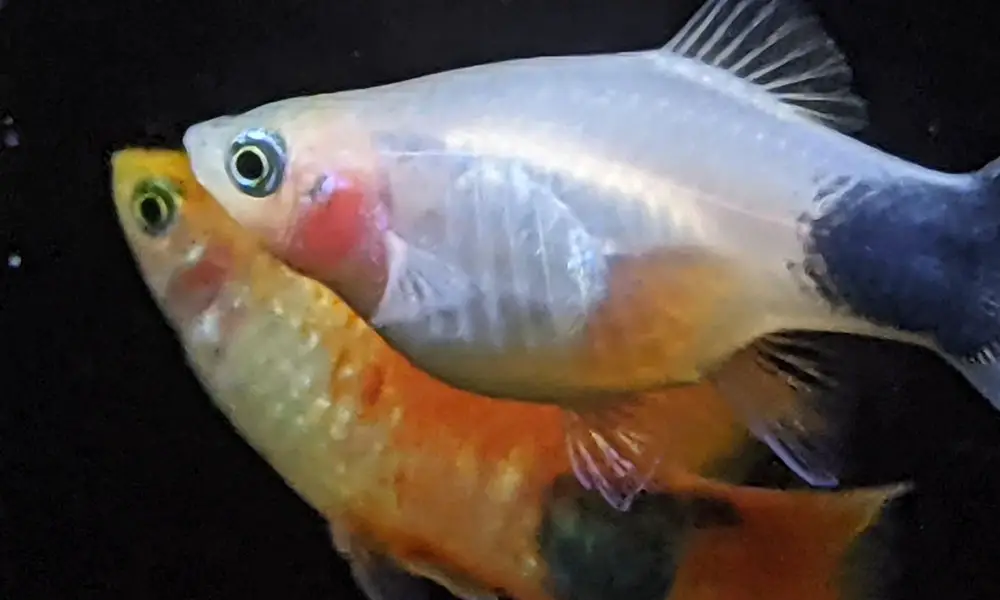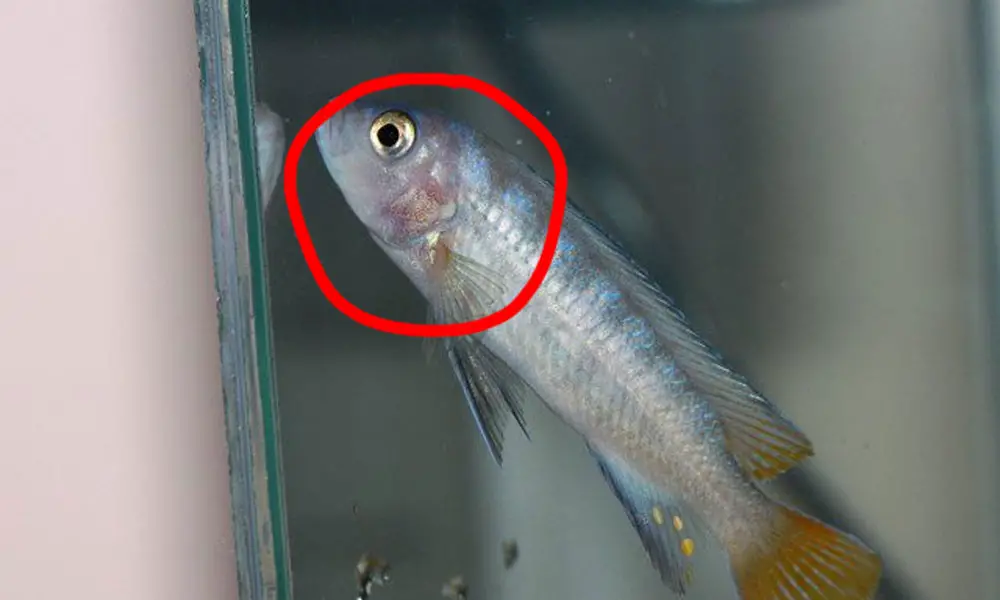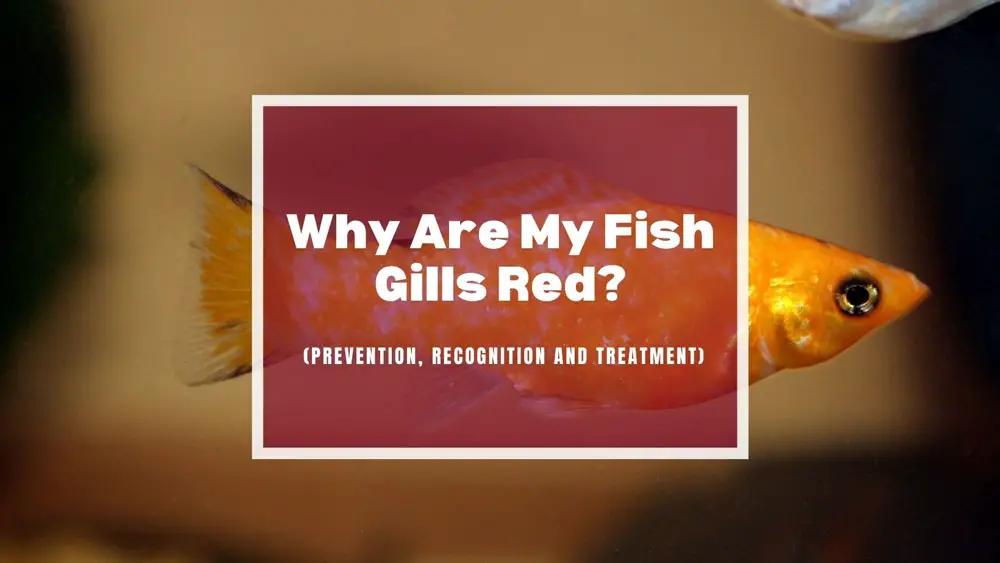If you’ve been keeping fish for some time, you’ve probably noticed that healthy fish gills are a pinkish-red color – a sign of good blood circulation and indicate that the fish is getting enough oxygen.
However, dark red or inflamed gills occur from time to time in both a new tank set up or an established tank. In fact, it usually means that the fish is sick or dying. But what you may not know is why red gills happen in the first place.
In this post, we will explore the causes of bright red gills in fish and provide some tips on keeping them healthy. Keep reading to learn more!
Healthy Gills Vs. Inflamed/Red Gills

In order to recognize the signs and symptoms of unhealthy gills so that you can take action to save your fish, it’s important to know what healthy gills look like.
Let’s start with the differences between healthy and red or inflamed gills.
Coloration
One of the first things you’ll notice about unhealthy gills is that they often take on a darker red or purple coloration. Without treatment, the gill and fin tissues will start to deteriorate and necrotize, and you may see red streaks or ulcers on the body and fins.
Appearance
In addition to changes in color, red or inflamed gills will often look swollen and may be covered in mucus. This is simply because the white blood cells are working overtime to fight the infection, and this can cause the gills to look puffy.
Behavior
One of the telltale signs that something is wrong with your fish’s gills is if you notice unnatural behaviors, such as gills opening and closing more rapidly or staying open partially. This is often a sign that the fish is not getting enough oxygen and having trouble breathing.
If you see this, it’s important to take immediate action as the fish may not be able to survive much longer.
Why Are My Fish Gills Red?

Inflamed or red gills usually indicate that your fish is suffering from diseases and infections. When you notice these symptoms, you should aim to identify the major cause so that you can treat the issue accordingly.
Here are some of the most common causes of red gills in fish:
Ammonia poisoning
Ammonia poisoning is one of the leading causes of death in aquarium fish. Though it’s not a common bacteria or parasite, it can often occur in fish tanks – especially during a new tank set up.
Of course, the ammonium level can increase suddenly or over a few days in an established tank for the following reasons.
- Add too many fish at once
- Your filter isn’t working properly due to a power or chemical outage
- Overcrowding decaying leaves or fish food
- A significant number of beneficial bacteria were lost due to the use of aquarium medication
- A sudden change in water conditions
Symptoms of Ammonia Poisoning in Fish
Elevated ammonia will irritate your fish’s gills, causing redness and inflammation. If ammonia levels rise too high, it will burn the delicate tissue in the gills, resulting in ulceration and eventually death. Ammonia levels should be zero in ideal aquarium water parameters.
Chronic low-level exposure to ammonia will also suppress the fish’s immune system, making them more susceptible to other diseases.
Ammonia is fatal to any freshwater fish, such as Bettas. If your ammonia levels spike, you may notice:
- Red or bloody gills
- Your fish gasping at the surface
- Loss of appetite and becoming lethargic
Treatment of Ammonia Poisoning in Fish
The first thing to do is to test your water for ammonia levels. If the levels are high, you’ll need to do a water change immediately. Removing decaying leaves or fish food from the tank is also important as these can contribute to ammonia levels.
Regular monitoring of your water parameters is the best way to prevent ammonia poisoning. Test your water at least once a week and perform regular water changes to keep the levels in check.
Gill Flukes
If your water conditions are in good shape, then you might be dealing with gill flukes.
Like other fish illnesses, parasite infestations are more common in home aquariums.
Gill flukes, also known as species of Dactylogyrus, are monogenean parasites usually found on fish’s gills. These parasites have two pairs of anchors used to attach themselves to the gills and feed on the blood and tissue of the fish.
Symptoms of Gill Flukes in Fish

Because these parasites attach themselves to the gills, you’ll notice that your fish has difficulty breathing. This is because the parasites are damaging the tissue in the gills and causing inflammation.
Affected fish will present similar signs or symptoms associated with bacterial gill disease (more below).
- Gasping at the surface or labored breathing
- Red, inflamed gills with excess mucus
- Opaque body with a mucus coating
- Flicking and rubbing
- Darting around the tank or erratic swimming
- Loss of appetite
Treatment
Like other monogeneans, Dactylogyrus species only require one host to complete their life cycle, which means that they can perpetuate in a closed system, such as undesirable aquarium conditions.
To treat gill flukes, you’ll need to use a Parasite Treatment like API General Cure or PraziPro. These medications will help to rid your fish of the flukes and improve their overall health.
While flukes are often present in aquariums, they are not harmful under ideal conditions. However, if your fish is stressed due to poor water quality or crowding, the flukes can begin to multiply, causing an outbreak. Once it happens, you must take prompt treatment. The earlier you begin treatment, the better your chances are of saving your fish.
[amazon box=”B007R5M7V6″]Bacterial Gill Diseas
Bacterial gill disease (BGD) is a common infection that can affect both freshwater and saltwater fish, especially young fishes. It’s caused by a variety of different bacteria, the most common being species primarily from genus Flavobacteria, Aeromonas, and Pseudomonas.
This bacteria thrives in dirty and crowded tanks. It can also be spread through contact with other infected fish or contaminated equipment.
Symptoms

Since the gills are mostly affected, you’ll notice the following symptoms:
- Gills take on red or brown and become inflamed
- Red spots on the gills and pectoral fins
- Visibly rapid or labored breathing
- The gills may secrete mucus
- Fish may gasp for air
- Loss of appetite
It’s not clear exactly how they cause all these damages directly, but they will often be considered secondary invaders. In other words, they are not the primary cause of the illness, such as incubating parasites or physical injury, but they can make the situation worse, particularly in poor water conditions and/or poor nutrition.
Treatment
Bacterial gill disease is a serious disease. You must quarantine the affected fish in a separate tank and treat them with broad spectrum antibiotics. I recommended using Fritz Maracyn 2 or API Fin And Body Cure to make medicated food, which is the most effective way to treat bacterial infections.
[amazon box=”B06XDFJ5XN”]Treating bacterial gill disease (BGD) can be tricky, and you must be diligent in your efforts. There are three reasons for this.
First, as I mentioned before, BGD is often a secondary infection resulting from another underlying condition. It’s almost impossible to correctly diagnose the specific bacteria without a gill biopsy.
Second, because the bacteria are ubiquitous (found everywhere), they can quickly re-infect your fish after treatment.
Third, some antibiotics can be harmful to your biological filter.
To increase the success rate of treating bacterial gill disease, you must figure out and remove the underlying cause. This may require knowledge of fish pathology.
How to Prevent Red Gills on Fish?
As any fish keeper knows, a healthy aquarium is a happy aquarium.
Almost all health problems can be traced back to three root causes: water quality, diet, and stress.
Water quality is often the most overlooked factor in a fish tank. Your fish are breathing in this water day and night, so it’s important to make sure it’s clean and free of toxins. Ammonia, nitrites, and nitrates should all be at 0 ppm. If they’re not, you’ll need to do a water change.
A healthy diet is also important for your fish. They need a balanced diet of proteins, fats, and carbohydrates to stay healthy. Poor diet weakens their immune system and makes them more susceptible to disease.
Finally, stress is the number one killer of fish. It can be caused by many factors, such as poor water quality, overcrowding, bullying, or even just a sudden change in the aquarium. If your fish are stressed, they will be more susceptible to illness.
Final Words
Hobbyists who are new to the red gills on fish conditions often get worried and think that it is something deadly. However, you can easily treat and prevent red gills on fish with some knowledge.
I hope this article has helped you understand red gills on fish and how to deal with them. Virtually all fish illnesses can be prevented by following the three golden rules of fish keeping: clean water, a good diet, and a stress-free environment.
If you have any questions about red gills, you can always get in touch with us via our social media or website. We would be happy to help you out!
